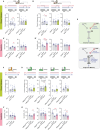Memory-like states created by the first ethanol experience are encoded into the Drosophila mushroom body learning and memory circuitry in an ethanol-specific manner
- PMID: 39899623
- PMCID: PMC11801723
- DOI: 10.1371/journal.pgen.1011582
Memory-like states created by the first ethanol experience are encoded into the Drosophila mushroom body learning and memory circuitry in an ethanol-specific manner
Abstract
A first ethanol exposure creates three memory-like states in Drosophila. Ethanol memory-like states appear genetically and behaviorally paralleled to the canonical learning and memory traces anesthesia-sensitive, anesthesia-resistant, and long-term memory ASM, ARM, and LTM. It is unknown if these ethanol memory-like states are also encoded by the canonical learning and memory circuitry that is centered on the mushroom bodies. We show that the three ethanol memory-like states, anesthesia-sensitive tolerance (AST) and anesthesia resistant tolerance (ART) created by ethanol sedation to a moderately high ethanol exposure, and chronic tolerance created by a longer low concentration ethanol exposure, each engage the mushroom body circuitry differently. Moreover, critical encoding steps for ethanol memory-like states reside outside the mushroom body circuitry, and within the mushroom body circuitry they are markedly distinct from classical memory traces. Thus, the first ethanol exposure creates distinct memory-like states in ethanol-specific circuits and impacts the function of learning and memory circuitry in ways that might influence the formation and retention of other memories.
Copyright: © 2025 Larnerd et al. This is an open access article distributed under the terms of the Creative Commons Attribution License, which permits unrestricted use, distribution, and reproduction in any medium, provided the original author and source are credited.
Conflict of interest statement
The authors have declared that no competing interests exist.
Figures











Similar articles
-
Rapid and Chronic Ethanol Tolerance Are Composed of Distinct Memory-Like States in Drosophila.J Neurosci. 2023 Mar 22;43(12):2210-2220. doi: 10.1523/JNEUROSCI.1348-22.2023. Epub 2023 Feb 7. J Neurosci. 2023. PMID: 36750369 Free PMC article.
-
Drosophila learning and memory centers and the actions of drugs of abuse.Learn Mem. 2024 Jun 11;31(5):a053815. doi: 10.1101/lm.053815.123. Print 2024 May. Learn Mem. 2024. PMID: 38862166 Free PMC article. Review.
-
Two Components of Aversive Memory in Drosophila, Anesthesia-Sensitive and Anesthesia-Resistant Memory, Require Distinct Domains Within the Rgk1 Small GTPase.J Neurosci. 2017 May 31;37(22):5496-5510. doi: 10.1523/JNEUROSCI.3648-16.2017. Epub 2017 Apr 17. J Neurosci. 2017. PMID: 28416593 Free PMC article.
-
Selective suppression and recall of long-term memories in Drosophila.PLoS Biol. 2019 Aug 27;17(8):e3000400. doi: 10.1371/journal.pbio.3000400. eCollection 2019 Aug. PLoS Biol. 2019. PMID: 31454345 Free PMC article.
-
Relationship between general anesthesia and memory in Drosophila involving the cAMP/PKA pathways and adhesion-related molecules.Curr Med Chem. 2007;14(13):1479-88. doi: 10.2174/092986707780831140. Curr Med Chem. 2007. PMID: 17584057 Review.
References
MeSH terms
Substances
Grants and funding
LinkOut - more resources
Full Text Sources
Medical
Molecular Biology Databases

